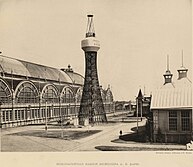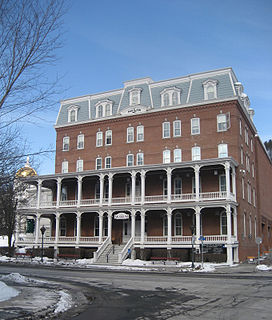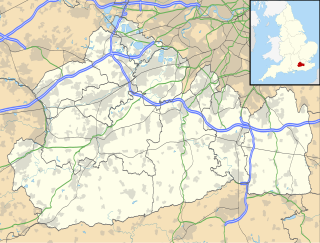Related Research Articles

Eduardo Fernando Catalano was an Argentine architect.

Alice Tully Hall is a concert hall at the Lincoln Center for the Performing Arts in Upper West Side, Manhattan, New York City. It is named for Alice Tully, a New York performer and philanthropist whose donations assisted in the construction of the hall. Tully Hall is located within the Juilliard Building, a Brutalist structure, which was designed by renowned architect Pietro Belluschi, and completed and opened in 1969. Since its opening, it has hosted numerous performances and events, including the New York Film Festival. Tully Hall seats 1,086 patrons.

J. S. Dorton Arena is a 7,610-seat multi-purpose arena located in Raleigh, North Carolina, on the grounds of the North Carolina State Fair. It opened in 1952.

Hyperboloid structures are architectural structures designed using a hyperboloid in one sheet. Often these are tall structures such as towers where the hyperboloid geometry's structural strength is used to support an object high off the ground, but hyperboloid geometry is also often used for decorative effect as well as structural economy. The first hyperboloid structures were built by Russian engineer Vladimir Shukhov (1853–1939). The world's first hyperboloid tower is located in Polibino, Dankovsky District, Lipetsk Oblast, Russia.
Frederickson Fieldhouse was an athletics facility on the campus of Oklahoma City University in Oklahoma City, Oklahoma. It was built in honor of a major OCU benefactor, George Frederickson, of Oklahoma City. It was built by the John Henry Frederickson, Jr. Construction company, also of Oklahoma City. John Frederickson was the General Contractor, and his son, Chris Frederickson, also worked on the job as a laborer. George Frederickson was the uncle of John Henry Frederickson, Jr.. In his gift to OCU, George stipulated that the building should be built by his nephew, John Henry.

The Pavilion is the principal workplace of the Governor of Vermont, located at 109 State Street in Montpelier, capital of the U.S. state of Vermont. The building is built in the French Second Empire style, and houses the working offices, reception room, press briefing room, and living apartments of Vermont's governor. The term "The Fifth Floor" is sometimes used as a metonym for a governor's administration, or the Vermont governorship, which refers to the location of the governor's offices on the fifth floor of the Pavilion. The offices of two other elected statewide officials, the Vermont Attorney General and the Vermont State Treasurer, are housed in the Pavilion along with the Agency of Administration and the Vermont Historical Society and its museum.

The North Carolina Executive Mansion is the official residence of the Governor of North Carolina and their family. Building began in the year 1883 and it was designed by architects Samuel Sloan and A.G. Bauer. The first occupants, Governor Daniel G. Fowle and his family, moved into the unfinished building in January 1891. It is an example of Queen Anne style architecture.

The Ritcher House is considered to be one of the best examples of Frank Lloyd Wright's Usonian mode of design in North Carolina. Located near downtown Raleigh, the house is one of many Modernist houses that were built in the city during the mid-20th century. Most of these homes were designed by faculty members of the North Carolina State University School of Design. Established in 1948 by Henry Kamphoefner, the school hired several Modernist architects as faculty members. Kamphoefner was awarded the North Carolina Award for Fine Arts in 1978 for his work and for his encouragement of other Modernists to build and design homes in the state. On September 21, 1994, the Ritcher House was listed on the National Register of Historic Places. The house is also a Raleigh Historic Landmark.

The Henry L. Kamphoefner House was the first Modernist house built in Raleigh, North Carolina. During the mid-20th century, faculty members from the School of Design located at North Carolina State College designed and built several modernist houses in Raleigh for themselves, other faculty, and a few clients. Henry L. Kamphoefner, originally the head of the University of Oklahoma's architecture program, became the first dean of the college's School of Design. Kamphoefner was awarded the North Carolina Award for Fine Arts in 1978 for his work and encouragement of other Modernists to build and design homes in the state. In 1977 he was awarded the Topaz Medallion for Lifelong Achievement in Architecture by the Association of Collegiate Schools of Architecture. The Kamphoefner House was listed on the National Register of Historic Places in 1996 and is designated a Raleigh Historic Landmark.
In architecture, a free plan is an open plan with non-load-bearing walls dividing interior space. In this structural system, the building structure is separate of the interior partitions. This is made possible by replacing interior load-bearing walls with moving the structure of the building to the exterior, or by having columns that are free from space dividing partitions.

The Church Army Chapel at Vanbrugh Park, Blackheath, Greater London, designed by project architect E.T. Spashett for Austin Vernon & Partners, opened in 1965 by Princess Alexandra and consecrated by Michael Ramsey, is a locally listed building of outstanding architectural significance, and is notable for originally having had the tallest sectional aluminium spire of its time, and for being one of the earliest 20th-century chapels of modern design to have been conceived with a central altar. It is now part of Blackheath High School.

Hugh Segar "Sam" Scorer FRSA was an architect who worked in Lincoln, England and was a leading pioneer in the development of hyperbolic paraboloid roof structures using concrete. He also was involved in architectural conservation and research into the work of local 19th-century architects, as well as creating an art gallery in Lincoln, now known as the Sam Scorer Gallery.

William Nichols, Sr. was an English-born architect who emigrated to the United States and became most famous for his early Neoclassical-style buildings in the American South. He is best known for designing early statehouses for North Carolina, Alabama and Mississippi.

The ASM International Headquarters and Geodesic Dome, at the Materials Park campus in Russell Township, Geauga County, Ohio, United States, are the headquarters of ASM International, a professional organization for materials scientists and engineers. These modernist structures were built in 1958 and dedicated in September 1959.

The Hughes-Young House, most commonly known as Mistletoe Villa, is a historic house in Henderson, North Carolina. The house is often cited for its ornate Victorian detail and architectural elements. The first house on the site was built for William H. Hughes and completed in 1855. From 1883 to 1885 the house was significantly redesigned and overbuilt on the previous foundation for Ike J. Young, Civil War Colonel and four-term mayor of Henderson. The design of the current house is attributed to the famed architect Samuel Sloan but that fact has not been officially documented.

The Small House, also known as the Milton Small House, is a modernist house built on a steep hillside on the Lake Boone Trail in Raleigh, North Carolina. Built in 1951, the house was listed on the National Register of Historic Places in 1994.

Thomas Phifer is an American architect based in New York City.

Joldwynds is a modernist style house in Holmbury St Mary, Surrey, England, designed by architect Oliver Hill for Wilfred Greene, 1st Baron Greene. Completed in 1932, it is a Grade II listed building.

The Town Lake Gazebo is a historic gazebo on the south shore of Lady Bird Lake in Austin, Texas, beside Auditorium Shores. Built in 1969 to beautify the south shore of Lady Bird Lake, the gazebo was paid for by the National Association of Women in Construction and features eclectic architecture. The structure was listed on the National Register of Historic Places in 2020.